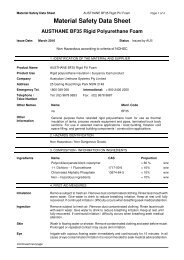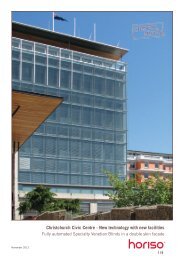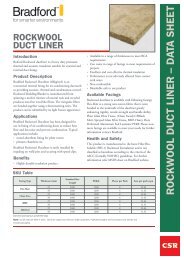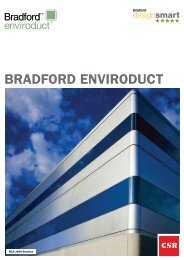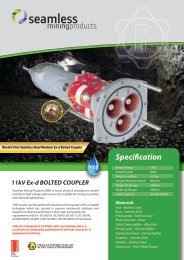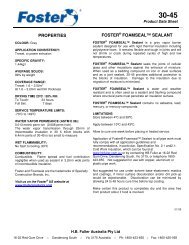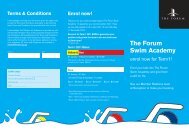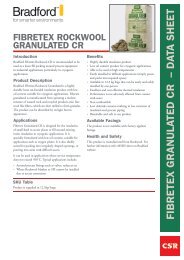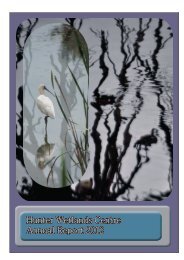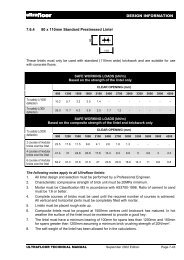FBS-1 Glasswool Insulation Products - Insulation Industries
FBS-1 Glasswool Insulation Products - Insulation Industries
FBS-1 Glasswool Insulation Products - Insulation Industries
You also want an ePaper? Increase the reach of your titles
YUMPU automatically turns print PDFs into web optimized ePapers that Google loves.
CSR MATERIAL SAFETY DATA SHEET<br />
<strong>FBS</strong>-1 <strong>Glasswool</strong> <strong>Insulation</strong> <strong>Products</strong><br />
SECTION 1: IDENTIFICATION OF THE MATERIAL AND SUPPLIER<br />
Product Name:<br />
Other Names:<br />
Product Codes/Trade Names:<br />
Recommended Use:<br />
Applicable In:<br />
<strong>FBS</strong>-1 <strong>Glasswool</strong> <strong>Insulation</strong> <strong>Products</strong><br />
<strong>FBS</strong>-1 Glass wool batts, Gold batts, <strong>FBS</strong>-1 insulation batts, insulation wool,<br />
Bradford, Acousticon, Acoustilag, Anticon, Ductwrap, Flexitel, Multitel,<br />
Quietel, Specitel, Supertel, Thermatel, Ultratel, Building Batts, Building<br />
Blanket, Partition Batts, Sectional Pipe <strong>Insulation</strong> - SPI, Light Appliance, Ductliner,<br />
ProTyle, Ceiling Panel Overlay, Gold insulation<br />
Gold Batts, Acousticon, Anticon, Ductwrap, Flexitel, Multitel, Quietel, Specitel,<br />
Supertel, Thermatel, Ultratel<br />
Thermal and acoustic insulation, energy conservation, building applications and<br />
appliance applications. Used in homes, public and commercial buildings, warehouses,<br />
industrial and petrochemical plants, motor vehicles, ships, public transport, marine,<br />
power station and whitegoods.<br />
Australia and New Zealand<br />
Supplier: CSR Building <strong>Products</strong> Limited ABN 55 008 631 356<br />
Address:<br />
9 Help Street, Chatswood NSW, 2067, AUSTRALIA<br />
Telephone: +61 2 9235 8000<br />
Email Address:<br />
bradfordwebenq@csr.com.au<br />
Facsimile: +61 2 9235 8044<br />
Emergency Phone Number:<br />
Poisons Information Centre:<br />
000 Fire Brigade and Police (available in Australia only)<br />
13 11 26 (available in Australia only)<br />
Because <strong>FBS</strong>-1 <strong>Glasswool</strong> <strong>Insulation</strong> products manufactured or sold in Australia and New Zealand by CSR Bradford are<br />
classified as NON-HAZARDOUS, a Material Safety Data Sheet (MSDS) is not strictly required under Australian<br />
Regulations. This model MSDS is issued by CSR Bradford for the information of users, installers and the community. It<br />
has been formatted in accordance with the Code on Preparation of a Material Safety Data Sheet 2003 Safe Work Australia<br />
(SWA – formerly ASCC/NOHSC).<br />
The information in this MSDS must not be altered, deleted or added to. The Supplier will not accept any responsibility for<br />
any changes made to its MSDS by any other person or organization. The Supplier will issue a new MSDS when there is a<br />
change in product specifications and/or ASCC standards, codes, guidelines, or Regulations.<br />
SECTION 2: HAZARD IDENTIFICATION<br />
STATEMENT OF HAZARDOUS NATURE: Classified as Non-Hazardous according to the criteria of the Australian Safety<br />
and Compensation Council ASCC (formerly NOHSC) Approved Criteria For Classifying Hazardous Substances [NOHSC:<br />
1008] 3rd Edition. <strong>FBS</strong>-1 <strong>Glasswool</strong> <strong>Insulation</strong> is classified as Non-Dangerous Goods according to the Australian Code for<br />
the Transport of Dangerous Goods by Road and Rail.<br />
CSR MSDS Reference:<br />
<strong>FBS</strong>-1 <strong>Glasswool</strong><br />
Date Issued: 17 th June 2009
MSDS for <strong>FBS</strong>-1 <strong>Glasswool</strong> <strong>Insulation</strong> Page 2 of 6<br />
SECTION 3: COMPOSITION / INFORMATION ON INGREDIENTS<br />
Chemical Name: Synonyms Proportion: CAS Number:<br />
Mineral glasswool fibre (amorphous, noncrystalline,<br />
bio-soluble – Note Q applicable)<br />
>85% -<br />
Heat-cured resin (fibre binding agent)
MSDS for <strong>FBS</strong>-1 <strong>Glasswool</strong> <strong>Insulation</strong> Page 3 of 6<br />
SECTION 7: HANDLING AND STORAGE<br />
Handling:<br />
These products are safe in use. Once installed, the product does not release dust or fibres.<br />
Handling, installing or removing the product may result in some dust and airborne fibre.<br />
Minimise eye or skin contact and inhalation during handling, installation and removal (see<br />
Section 8). Observe good personal hygiene, including washing hands before eating. Remove<br />
personal protective equipment before entering eating areas.<br />
Storage:<br />
Incompatibilities:<br />
Store in sealed container in cool, dry area, removed from foodstuffs. Ensure packages are<br />
adequately labelled, protected from physical damage, and sealed when not in use. Avoid<br />
packaging being stored under UV light (direct sunlight) for long periods.<br />
None<br />
SECTION 8: EXPOSURE CONTROLS / PERSONAL PROTECTION<br />
National Exposure Standards:<br />
None allocated for <strong>FBS</strong>-1 <strong>Glasswool</strong> <strong>Insulation</strong> products, which may be<br />
regarded as nuisance dusts.<br />
CSR recommends following the National Occupational Exposure Standard<br />
(NES) Australian Safety and Compensation Council, ASCC (formerly NOHSC)<br />
general guide to keep all occupational exposures to dust and other atmospheric<br />
contaminants to as low a level as is workable (practicable).<br />
For non-hazardous nuisance dusts: 2.0 mg/m 3 TWA for inspirable dusts and/or<br />
10 mg/m 3 TWA for total dust (of any type, or particle size) is recommended.<br />
Notes on Exposure Standards<br />
Biological Limit Values:<br />
Exposure Standard (TWA) is the time-weighted average airborne concentration<br />
over an eight-hour working day, for a five-day working week over an entire<br />
working life. According to current knowledge this concentration should not<br />
impair the health or cause undue discomfort to nearly all workers.<br />
Not applicable<br />
ENGINEERING CONTROLS<br />
Ventilation:<br />
Special Consideration for Repair<br />
&/or Maintenance of Contaminated<br />
Equipment:<br />
During most applications and installation no special ventilation will be required.<br />
However, if installing in dusty or poorly-ventilated areas, or during the first heatup<br />
cycle in high-temperature industrial applications, local exhaust ventilation<br />
should be considered. Work practices should aim to minimise the release of,<br />
and exposure to, fibres and/or dust. Hand tools generate the least amount of<br />
dust and fibres. If power tools are used directly on the product appropriate dust<br />
collection systems are recommended.<br />
Work areas should be cleaned regularly and vacuuming or wet sweeping is<br />
suggested. Use of personal protective equipment as outlined below is<br />
recommended during work in areas or on equipment where this product has<br />
been installed.<br />
PERSONAL PROTECTION EQUIPMENT<br />
Personal Hygiene<br />
Skin Protection:<br />
Washing of exposed skin with soap and water at the end of a shift or as<br />
required is recommended as a comfort measure.<br />
Direct skin contact can be minimised by wearing long-sleeved shirts and long<br />
trousers, a cap or hat, and standard duty gloves conforming to Australian<br />
Standard AS 2161. Work clothes should be washed regularly and separately<br />
from other clothes. Bradford Comfortsleeve TM gloves are recommended for<br />
improved comfort when handling and installing <strong>Glasswool</strong> <strong>Insulation</strong>.<br />
CSR SDS Reference:<br />
<strong>FBS</strong>-1 <strong>Glasswool</strong><br />
Date Issued: 17 th June 2009
MSDS for <strong>FBS</strong>-1 <strong>Glasswool</strong> <strong>Insulation</strong> Page 4 of 6<br />
Eye Protection:<br />
Respiratory Protection:<br />
Smoking & Other Dusts:<br />
When handling these products, particularly overhead or in enclosed or poorlyventilated<br />
areas such as ceiling spaces or risers, eye contact with dust or fibre<br />
can be avoided by wearing ventilated non-fogging dust resistant goggles<br />
conforming to Australian and New Zealand Standards AS/NZS 1336.<br />
None normally required. If dust is generated in enclosed or poorly-ventilated<br />
areas, an approved particulate respirator conforming to Australian and New<br />
Zealand Standards AS/NZS 1715 and 1716 is recommended. P1, P2 or N95<br />
type respirators are appropriate. Use only respirators that bear the Australian<br />
Standards mark and are fitted and maintained correctly, and kept in clean<br />
storage when not in use.<br />
Inhalation of airborne particles from other sources, including those from<br />
cigarette smoke, may increase the risk of lung disease. CSR recommends that<br />
all storage and work areas should be non-smoking zones, and other airborne<br />
contaminants be kept to a minimum.<br />
SECTION 9: PHYSICAL AND CHEMICAL PROPERTIES<br />
Appearance:<br />
Odour:<br />
pH, at stated concentration:<br />
Vapour Pressure/Density:<br />
Boiling Point/range (°C):<br />
Melting Point (°C):<br />
Solubility in water:<br />
Specific Gravity (H 2 O = 1):<br />
Decomposition<br />
Temperature<br />
Volatile Organic<br />
Compounds (VOC)<br />
content/Percent Volatiles:<br />
A matt of yellow fibrous material resembling wool. It is supplied in different shapes<br />
and sizes, in outer packaging. It may be rigid or flexible; and facings such as<br />
aluminium foil, vinyl, and synthetic tissues applied to meet specific purposes.<br />
Slight amine/sour odour, particularly when recently manufactured, then odourless<br />
Not applicable<br />
Not applicable<br />
Not applicable<br />
>704°C<br />
Insoluble<br />
Generally low, but variable depending on facings<br />
>300°C<br />
Very low;
MSDS for <strong>FBS</strong>-1 <strong>Glasswool</strong> <strong>Insulation</strong> Page 5 of 6<br />
Incompatible Materials:<br />
Hazardous<br />
Reactions/Decomposition <strong>Products</strong>:<br />
No reported incompatibilities. Acids, alkalis or organic solvents may cause<br />
degradation of resin binder.<br />
None known<br />
SECTION 11: TOXICOLOGICAL INFORMATION<br />
Toxicology data: The fibre component of these products is classified by Safe Work Australia (formerly ASCC/NOHSC) as<br />
Mineral Wool (Not Elsewhere Specified).<br />
In accord with EU ATP 31 (2009) these fibres are not classified as irritant, and being bio-soluble they are not regarded as<br />
carcinogenic. <strong>FBS</strong>-1 <strong>Glasswool</strong> <strong>Insulation</strong> fibres manufactured in Australia and New Zealand (since 2001) are bio-soluble,<br />
which means that any fibres inhaled into the lungs dissolve in body fluids and are then cleared from the lungs. They are<br />
certified as having low biopersistence, e.g. after inhalation, as specified under Note Q as listed in the Australian Hazardous<br />
Substances Information System and in the Australian Approved Criteria documentation. Fibres of these products comply<br />
with the short-term bio-persistence test and fulfil the requirements of Australian and international authorities on biosolubility.<br />
SWA (formerly ASCC/NOHSC) and international authorities do not classify mineral wool fibres with high biosolubility<br />
as carcinogenic or as capable of causing fibrosis.<br />
Fibres are generally clumped by the binder or resin coating and single strand respirable fibre is present only in trace<br />
amounts when any dust is formed in the workplace during installation. Bound fibre is not of respirable size. Extensive<br />
research over the past 50 years on workers handling these fibres and products in many countries has shown that the<br />
inspirable and respirable size fibres are not harmful, having no long term health effects or respiratory effects.<br />
Toxicology test data is generally not available on the products, but is estimated as being very low with LD50 >5000 mg/kg.<br />
Health Effects: Acute (short-term)<br />
Swallowed: Unlikely in normal use, but may result in temporary itching of the lips, mouth and throat. Attempting<br />
to swallow large amounts would be expected to cause gagging and possibly vomiting.<br />
Eyes:<br />
Skin:<br />
Inhaled:<br />
May cause eye discomfort resulting in watering and redness.<br />
Handling repeatedly during installation may cause temporary itching of exposed skin. This is not an<br />
allergy and usually disappears quickly.<br />
Unprotected exposure to high levels of dust of these products (during installation or removal) may<br />
cause discomfort of the nose, throat, and upper and lower respiratory tract, especially in persons<br />
suffering from upper respiratory or chest complaints such as hay fever, asthma or bronchitis.<br />
Note: <strong>Products</strong> used in high temperature applications (above 177°C) may release fumes from the resin bonding during<br />
initial heat-up. In these applications and where suitable protective equipment is not worn (see Section 8), then some<br />
irritation to the eyes, nose, throat and respiratory tract may occur. In confined or poorly ventilated areas, use air-supplied<br />
respirators during the first heat-up cycle.<br />
Health Effects: Chronic (long-term)<br />
There are no known long-term health effects.<br />
SECTION 12: ECOLOGICAL INFORMATION<br />
Eco-toxicity:<br />
Persistence and<br />
Degradability:<br />
Neither the raw materials nor the finished product contain any ozone-depleting chemicals. This<br />
product is not classified as a hazardous air pollutant. No specific data is available on<br />
ecotoxicity, but estimations based on toxicity information suggest that the materials in these<br />
products are not toxic to fish, birds insects or organisms in the environment. No harm to fish or<br />
wildlife would be caused by this product.<br />
<strong>FBS</strong>-1 <strong>Glasswool</strong> <strong>Insulation</strong> is bio-soluble and in most ecosystems it would be expected to<br />
solubilise over a period of weeks to months. Binder-coated insulation wool is hydrophobic, and<br />
no adverse environmental effects would be expected if accidentally released in water or soil.<br />
CSR SDS Reference:<br />
<strong>FBS</strong>-1 <strong>Glasswool</strong><br />
Date Issued: 17 th June 2009
MSDS for <strong>FBS</strong>-1 <strong>Glasswool</strong> <strong>Insulation</strong> Page 6 of 6<br />
SECTION 13: DISPOSAL CONSIDERATIONS<br />
Place in plastic bags or containers and close or seal for disposal in accordance with local authority guidelines. Label as<br />
NON-HAZARDOUS insulation wool or as general building waste (non-hazardous), as appropriate to assist local authorities<br />
waste disposal sites. Department of Environment and Climate Change NSW classifies glasswool insulation as General<br />
Solid Waste (non-putrescible), and local authorities will usually advise any local handling arrangements at their disposal<br />
sites.<br />
SECTION 14: TRANSPORT INFORMATION<br />
Transport<br />
Requirements:<br />
<strong>FBS</strong>-1 <strong>Glasswool</strong> <strong>Insulation</strong> products are not classified as Dangerous Goods and have no<br />
special transport requirements.<br />
UN number: None allocated Subsidiary Risk 1: None allocated<br />
DG Class: None allocated Packaging Group: None allocated<br />
HAZCHEM code:<br />
None allocated<br />
SECTION 15: REGULATORY INFORMATION<br />
Poisons Schedule:<br />
Not scheduled. No specific regulatory requirements are applicable regarding occupational<br />
health and safety, consumer protection or environmental protection measures.<br />
SECTION 16: OTHER INFORMATION<br />
For further information on this product, please contact:<br />
CSR Building <strong>Products</strong> Limited 9 Help Street, Chatswood NSW, 2067, AUSTRALIA<br />
Phone: 1800 819 618 (available in Australia only) Fax: 1800 647 260<br />
ADDITIONAL INFORMATION<br />
The following references are intended as guides to good industrial practice applicable to building and construction products.<br />
AS/NZS 1336<br />
AS/NZS 1715, 1716<br />
AS 2161<br />
Recommended Practices for Occupational Eye Protection<br />
Selection, Use and Maintenance of Respiratory Protective Devices<br />
Industrial Safety Gloves and Mittens (excluding electrical and medical gloves)<br />
AUTHORISATION<br />
Reason for Issue: Updated with latest OH&S assessment – supercedes issue date 09/2005<br />
Authorised by: Ray Thompson<br />
Date of Issue: 17 th June 2009<br />
Whilst the information contained in this document is based on data which, to the best of our knowledge, was accurate and<br />
reliable at the time of preparation, no responsibility can be accepted by us for errors and omissions. The provision of this<br />
information should not be construed as a recommendation to use any of our products in violation of any patent rights or in<br />
breach of any statute or regulation. Users are advised to make their own determination as to the suitability of this<br />
information in relation to their particular purposes and specific circumstances. Since the information contained in this<br />
document may be applied under conditions beyond our control, no responsibility can be accepted by us for any loss or<br />
damage caused by any person acting or refraining from action as a result of this information.<br />
END OF MSDS<br />
CSR SDS Reference:<br />
<strong>FBS</strong>-1 <strong>Glasswool</strong><br />
Date Issued: 17 th June 2009



